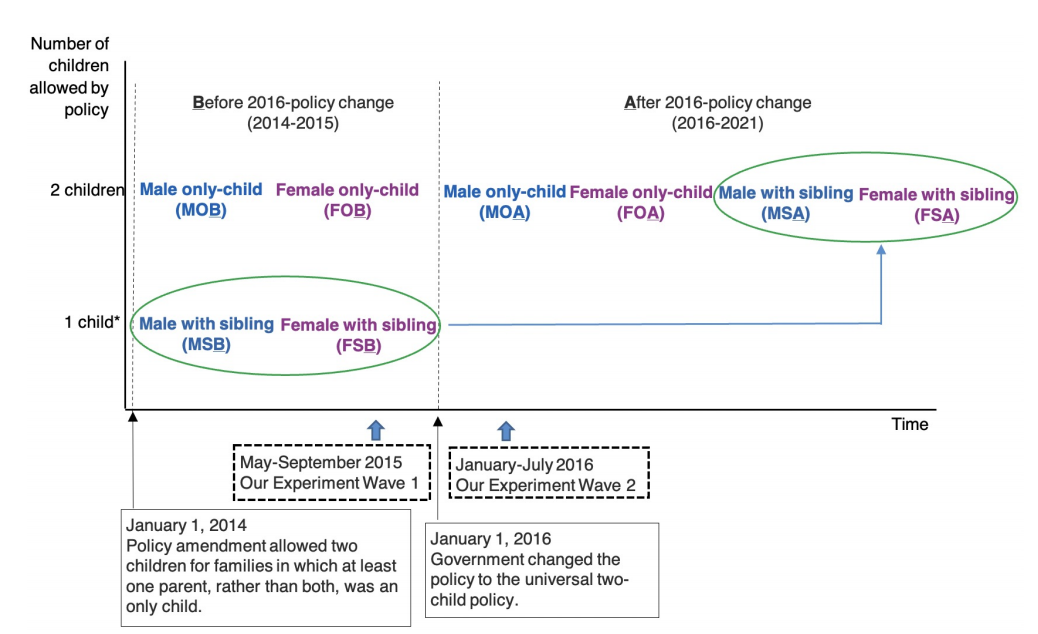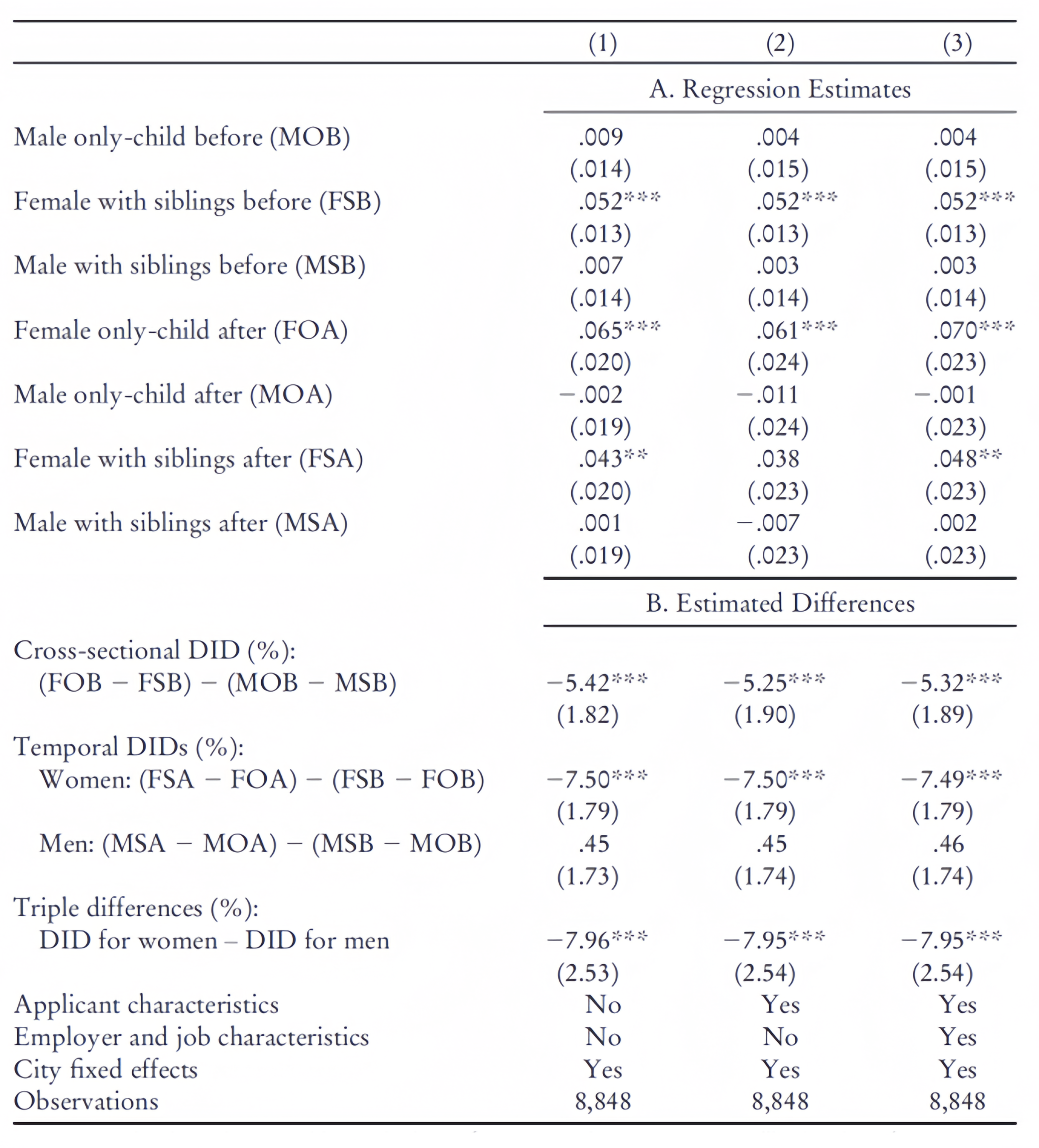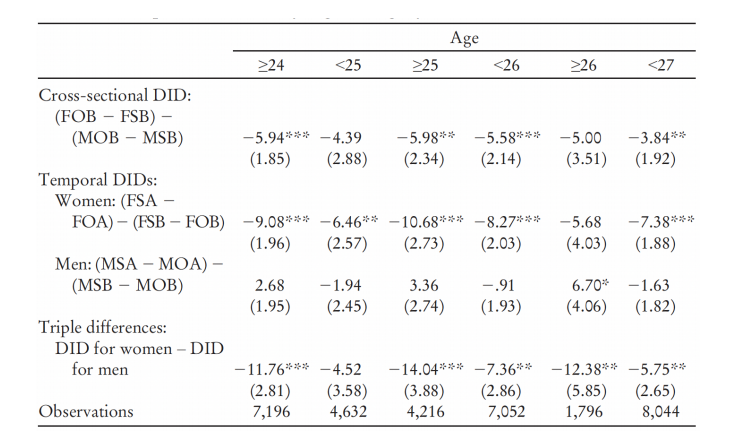Labor Market Discrimination against Family Responsibilities: A Correspondence Study with Policy Change in China
China shifted its controversial one-child policy (1979–2015) to a two-child policy in 2016. We take advantage of the unexpected timing of this policy change and the heterogeneities in the pre-change environment to investigate labor market discrimination against expected family responsibilities. In a two-wave correspondence study before and after the policy change, we sent 8,848 fictitious resumes with ages 22–29 in response to online job advertisements. Their gender and only-child/siblinged status were systematically varied. We find that women—but not men—are subject to labor market discrimination for expected family responsibilities, as employers anticipated that the 2016 policy would unleash pent-up demand for more children in the population. This discrimination worsens with the increase in women’s reproductive age.

Alarge and fruitful body of labor economics research uses audit or correspondence study methods and encompasses various aspects of labor market discrimination, including race, ethnicity, gender, age, unemployment status, and disability (Riach and Rich 2002, Rich 2014, Bertrand and Duflo 2017, Neumark 2018). However, one important area that has been understudied is labor market discrimination based on expected family responsibilities or parenthood. It is crucial to address this gap as employers may potentially discriminate against workers of childbearing age, particularly women, based on the expectation that they may be more inclined to leave their jobs due to childbirth and childcare responsibilities.
Family responsibilities or childbearing intentions are often unobservable by employers in the early hiring stages. Researchers employ indirect and direct approaches to tackle this challenge. The indirect approach involves using applicants’ other related characteristics, such as marital status (Maurer-Fazio and Wang 2018), age (Petit 2007; Helleseter, Kuhn, and Shen 2020), membership in parent organizations (Correll, Benard, and Paik 2007), or sexual orientation (Baert 2014), as proxies for their childbearing intentions and responsibilities. The evidence generally supports the existence of discrimination against those who (may) have family responsibilities. In contrast, Becker, Fernandes, and Weichselbaumer (2019) take a direct approach by explicitly signaling fictitious applicants’ marital status and children’s ages. They find supportive evidence of discrimination in hiring based on potential and realized fertility. One caveat of these studies pertains to their cross-sectional design, wherein employers encounter multiple signals infrequently seen in job applications. It may raise concerns of potential confounds and external validity as employers may perceive such signals as uncommon and react differently (Balfe et al. 2021).
In this paper, we conduct a two-wave correspondence study and take advantage of the heterogeneities in China’s birth policy in 2014–15 and the unexpected timing of the termination of the one-child policy in 2016 to investigate labor market discrimination based on expected family responsibilities.
China’s one-child policy, enacted in 1979, created a general restriction of one child per family. However, a major amendment implemented in 2014 and 2015 allowed qualified families, where at least one parent was an only child, to have two children. This amended policy, which tied birth restrictions to one’s sibling status (i.e., whether a person was an only child or had siblings), led to higher expected fertility rates among only-child adults relative to their siblinged counterparts (see Figure 1). These policy heterogeneities piqued our interest in researching family-related discrimination by leveraging the cross-sectional variations in individuals’ sibling status and gender.

Figure 1. Policy impact on each category
Notes: The figure illustrates where each group stands regarding the policy-allowed fertility before (B) and after (A) the 2016 policy change. The oval highlights the groups treated by the 2016 policy change. Asterisk indicates that during 2014 and 2015, those with siblings could have only one child unless their spouses were an only child.
On October 29, 2015, during our data collection, the government unexpectedly announced the shift to a universal two-child policy. It allowed all families to have up to two children, delinking limitations on children per family from the parents’ sibling status, effective January 1, 2016. This new policy increased the expected fertility for siblinged men and women (representing the treatment groups) but did not affect only-child adults (representing the control groups).We thus extended our original cross-sectional design to combine a two-wave field experiment with this natural experiment (the policy change) to establish causal relationships regarding labor market discrimination related to family responsibilities.
We conducted this experiment in China’s three most economically advanced megacities before and after the 2016 policy change. We sent 8,848 fictitious resumes, featuring individuals aged between 22 and 29, in response to real online job advertisements. For each job listing, we dispatched four resumes, systematically altering the fictitious applicants’ gender and sibling status to signal information related to their expected fertility. Our resumes explicitly mentioned the gender of the fictitious applicants. Additionally, we incorporated the sibling status signal within the self-assessment section of the resume template. It started with the phrase, “[a]s the only child (or one of the children) in my family,” followed by a personal statement describing traits indicative of a strong employee. These fictitious applicants possessed either a three-year associate’s degree or a four-year bachelor’s degree, with work experience ranging from zero (exclusive) to five (inclusive) years. This information was adapted from actual resumes to align with the specific job requirements.
We focused on the two dominant industries in each city based on the highest number of job listings in the two months preceding our experiment. These industries were internet and finance in Shanghai, internet and fast-moving consumer goods in Guangzhou, and internet and electronics in Shenzhen. Within each of these industries, we selected the three most sought-after job categories: sales, administrative assistance, and customer service.
For each randomly selected, newly posted job ad that met our selection criteria, we sent the four resumes in a random order, one per day over four consecutive days. We defined success as the receipt of a callback (i.e., a phone call, email, or text message from the employer) within two weeks.
Our analysis begins with a pre-policy cross-sectional difference-in-differences (DID) approach. Panel B of Table 1 shows that before 2016, when only-child adults were granted the opportunity to have one more child than siblinged adults, there was a noticeable disparity in callback rates. Specifically, only-child women received differentially fewer callbacks than their siblinged female counterparts relative to men ((FOB - FSB) - (MOB - MSB)). This is suggestive evidence of discrimination against women based on family responsibilities.
Table 1. Determinants of the Callbacks (OLS)

Notes: The dependent variable is whether a fictitious applicant receives a callback. The reference group (omitted) in the regressions is FOB, i.e., female only-child applicants before the policy change. The callback for FOB is 30.11%. The applicants’ characteristics include age, education, years of work experience, number of previous jobs, college major, and university fixed effects. Job and firm characteristics include occupations, number of applications submitted to the ad, number of people who followed the firm on the job board, firm size, ownership, and industry type. Standard errors (in parentheses) are clustered at the job ad level. Panel B provides the differences in estimates in panel A and the corresponding Wald tests, with standard errors in parentheses.
** significant at the 5% level.
***significant at the 1% level.
We then expand our analysis to include temporal DIDs that leverage the policy change for more rigorous causal identification. We find that siblinged women—once allowed an additional child because of the 2016 policy change—experienced differentially fewer callbacks than only-child women whose legal fertility remained unchanged ((FSA - FOA) - (FSB - FOB)). This impact is not observed among men ((MSA - MOA) - (MSB - MOB)). This finding is more rigorous casual evidence of discrimination based on family responsibilities against women.
We further construct a triple-differences estimator, building on the temporal DIDs for women and men to account for temporal variations that would similarly affect both genders, [(FSA - FOA) - (FSB - FOB)] - [(MSA - MOA) - (MSB - MOB)] in Table 1. The results show that the adverse change resulting from the new policy, as evidenced by the callback difference between siblinged and only-child women, is more pronounced than the corresponding change observed between siblinged and only-child men. This approach yields an even more rigorous and causal estimate of family-based discrimination relative to the temporal DIDs.
Moreover, as illustrated in Table 2, we find that age plays a moderating role in this discrimination against women. Specifically, we observe more pronounced discrimination against siblinged women in their late 20s, which represents the upper age limit in our sample. This finding aligns with the prevailing social norms in China and is consistent with the likelihood of employers holding the belief that women in this age bracket are more inclined to have a pent-up desire for children compared to those under 25. The lack of this age-related pattern for men accentuates the fact that family-based discrimination is a phenomenon directed at women.
Table 2. DIDs and Triple Differences by Age Category (%)

Notes: Similar to Table 1, we conduct OLS analyses with only the treatment dummies and no other covariates. Standard errors (in parentheses) are clustered at the job ad level. Results are similar if we include all covariates in the OLS. The two subsamples below ages 24 and 27 or above are too small to render accurate estimates and are not reported here.
* significant at the 10% level.
** significant at the 5% level.
***significant at the 1% level.
Finally, further results from occupation-specific analysis corroborate our main result that women, not men, are negatively affected by perceived family responsibilities.
Taken together, our research provides compelling evidence of labor market discrimination based on expected family responsibilities that specifically targets women, particularly those in their late 20s who are approaching their peak childbearing years.
A direct implication of our study is that the introduction of new policies, including those that remove birth limits, may be insufficient to reverse the declining birth rate unless policymakers effectively address discrimination in the labor market against women’s (expected) family responsibilities. Policymakers may reconsider their complementary policies (e.g., increasing parental leave) intended to help working women which, unfortunately, may unintentionally disadvantage them (e.g., Lalive and Zweimüller 2009). Exploring options like providing financial incentives to employers to reduce costs associated with hiring or retaining working women could be a meaningful step forward.
(Haoran He, Jingshi Chair Professor of Economics and Co-Director of the Center for Game Theory Decision and Behavior at Beijing Normal University; Sherry Xin Li, Lewis E. Epley Jr. Professor of Economics at University of Arkansas; Yuling Han, graduate student at Beijing Normal University)
References
Albert, Rocío, Lorenzo Escot, and José Andrés Fernández-Cornejo. 2011. “A Field Experiment to Study Sex and Age Discrimination in the Madrid Labour Market.” International Journal of Human Resource Management 22 (2): 351–75. https://doi.org/10.1080/09585192.2011.540160.
Baert, Stijn. 2014. “Career Lesbians: Getting Hired for Not Having Kids?” Industrial Relations Journal 45 (6): 543–61. https://doi.org/10.1111/irj.12078.
Balfe, Catherine, Patrick Button, Mary Penn, and David Schwegman. 2021. “Infrequent Identity Signals and Detection Risks in Audit Correspondence Studies.” NBER Working Paper No. 28718. http://doi.org/10.3386/w28718.
Becker, Sascha O., Ana Fernandes, and Doris Weichselbaumer. 2019. “Discrimination in Hiring Based on Potential and Realized Fertility: Evidence from a Large-Scale Field Experiment.” Labour Economics 59: 139–52. https://doi.org/10.1016/j.labeco.2019.04.009.
Bertrand, Marianne, and Esther Duflo. 2017. “Field Experiments on Discrimination.” In Handbook of Economic Field Experiments, vol. 1, edited by Abhijit Vinayak Banerjee and Esther Duflo. Amsterdam: North Holland. https://doi.org/10.1016/bs.hefe.2016.08.004.
Bygren, Magnus, Anni Erlandsson, and Michael Gähler. 2017. “Do Employers Prefer Fathers? Evidence from a Field Experiment Testing the Gender by Parenthood Interaction Effect on Callbacks to Job Applications.” European Sociological Review 33 (3): 337–48. https://doi.org/10.1093/esr/jcx051.
Correll, Shelley J., Stephen Benard, and In Paik. 2007. “Getting a Job: Is There a Motherhood Penalty?” American Journal of Sociology 112 (5): 1297–339. https://doi.org/10.1086/511799.
Helleseter, Miguel Delgado, Peter Kuhn, and Kailing Shen. 2020. “The Age Twist in Employers’ Gender Requests Evidence from Four Job Boards.” Journal of Human Resources 55 (2): 428–69. https://doi.org/10.3368/jhr.55.3.0416-7836R2.
Lalive, Rafael, and Josef Zweimüller. 2009. “How Does Parental Leave Affect Fertility and Return to Work? Evidence from Two Natural Experiments.” Quarterly Journal of Economics 124 (3): 1363–402. https://doi.org/10.1162/qjec.2009.124.3.1363.
Maurer-Fazio, Margaret, and Sili Wang. 2018. “Does Marital Status Affect How Firms Interpret Job Applicants’ Un/employment Histories? International Journal of Manpower 39 (4): 567–80. https://doi.org/10.1108/IJM-09-2017-0251.
Neumark, David. 2018. “Experimental Research on Labor Market Discrimination.” Journal of Economic Literature 56 (3): 799–866. https://doi.org/10.1257/jel.20161309.
Petit, Pascale. 2007. “The Effects of Age and Family Constraints on Gender Hiring Discrimination: A Field Experiment in the French Financial Sector.” Labour Economics 14 (3): 371–91. https://doi.org/10.1016/j.labeco.2006.01.006.
Reuters. 2015. “China Says One-Child Policy Stays in Effect for Now.” Reuters, November 1. https://www.reuters.com/article/us-china-population/china-says-one-child-policy-stays-in-effect-for-now-idUSKCN0SR0E020151102.
ReutersRiach, Peter A., and Judith Rich. 2002. “Field Experiments of Discrimination in the Market Place.” Economic Journal 112 (483): F480–F518. https://doi.org/10.1111/1468-0297.00080.
Rich, Judith. 2014. “What Do Field Experiments of Discrimination in Markets Tell Us? A Meta Analysis of Studies Conducted since 2000.” IZA Discussion Paper No. 8584. https://doi.org/10.2139/ssrn.2517887

Latest
Most Popular
- VoxChina Covid-19 Forum (Second Edition): China’s Post-Lockdown Economic Recovery VoxChina, Apr 18, 2020
- China’s Great Housing Boom Kaiji Chen, Yi Wen, Oct 11, 2017
- China’s Joint Venture Policy and the International Transfer of Technology Kun Jiang, Wolfgang Keller, Larry D. Qiu, William Ridley, Feb 06, 2019
- Wealth Redistribution in the Chinese Stock Market: the Role of Bubbles and Crashes Li An, Jiangze Bian, Dong Lou, Donghui Shi, Jul 01, 2020
- The Dark Side of the Chinese Fiscal Stimulus: Evidence from Local Government Debt Yi Huang, Marco Pagano, Ugo Panizza, Jun 28, 2017
- What Is Special about China’s Housing Boom? Edward L. Glaeser, Wei Huang, Yueran Ma, Andrei Shleifer, Jun 20, 2017
- Privatization and Productivity in China Yuyu Chen, Mitsuru Igami, Masayuki Sawada, Mo Xiao, Jan 31, 2018
- Evaluating Risk across Chinese Housing Markets Yongheng Deng, Joseph Gyourko, Jing Wu, Aug 02, 2017
- How did China Move Up the Global Value Chains? Hiau Looi Kee, Heiwai Tang, Aug 30, 2017
- China’s Shadow Banking Sector: Wealth Management Products and Issuing Banks Viral V. Acharya, Jun Qian, Zhishu Yang, Aug 09, 2017




 Facebook
Facebook  Twitter
Twitter  Instagram
Instagram WeChat
WeChat  Email
Email 


